
Communicating in a different language is just a matter of putting the right words in the right order, isn’t it?
Not exactly.
There are ten things all people do when they communicate, missionary Richard Rees learned in an advanced language workshop in Thailand this month. Jill Goring traveled from the offices where we serve in Sanford, Florida, to put on the workshop, part of NTM’s continuing education program for missionaries.
Those ten things are:
- Adjust to the situation
- Always have a purpose
- Organize what we say
- Monitor the hearer
- Talk in “chunks” (paragraphs)
- “Glue” thoughts together
- Identify/mark what is important
- Keep track of participants
- Make clear “who said what” (quotes)
- Add spice (figures of speech)
“We all know how to do those things in English,” Richard wrote. “As a matter of fact, I am doing those things (hopefully successfully) as I am writing this. But every language does these things differently, and if I carry my English methods and patterns over to the Karen language, I will not communicate well, or more likely, I will miscommunicate.”
Each of the missionaries brought texts in the languages they work in. Using a computer spreadsheet, they learned how to isolate each of those elements in the text.
“Sound like a lot of work?” Richard asked. “Yes, it is. Is it worth the time and energy? Well, think about it with me for a second.
“If I am teaching Bible lessons, but not adjusting them to the situation I am in, will they communicate well?
“Or what if I translate a Bible passage, but haven’t made clear the purpose of the passage?
“What if my teaching is not organized in a way the people recognize or I am not accurately keeping track of whether the hearers are following what is being taught?
“What if in Bible translation I throw in too many words or phrases that indicate paragraph breaks and the passage becomes disjointed, or I ignore the markers and it becomes one long boring passage that no one wants to read?”
To communicate clearly, you need to get each facet of communication right. And the bottom line is, God put a lot of effort into communicating clearly, so we should mirror His commitment.
Leave a Reply